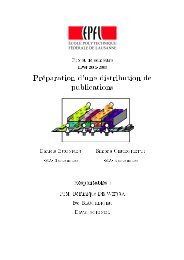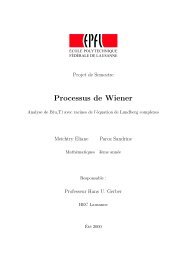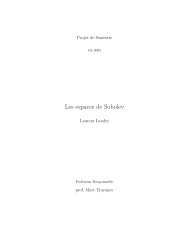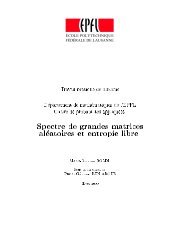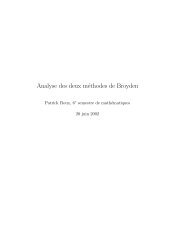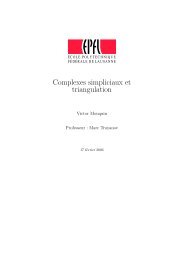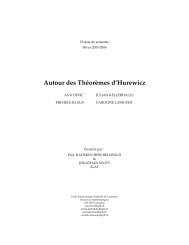Identification du dual topologique de C[a, b] Louis ... - CQFD - EPFL
Identification du dual topologique de C[a, b] Louis ... - CQFD - EPFL
Identification du dual topologique de C[a, b] Louis ... - CQFD - EPFL
You also want an ePaper? Increase the reach of your titles
YUMPU automatically turns print PDFs into web optimized ePapers that Google loves.
2. L’INTEGRALE DE STIELTJES 11<br />
On constate donc que g ∈ BV [a, b], et par conséquent que g est à variation<br />
bornée sur tout sous-intervalle <strong>de</strong> [a, b]. Ainsi :<br />
∫ b<br />
m∑<br />
∫ ci+1<br />
(1)<br />
f(x)dg(x) = f(x)dg(x)<br />
a<br />
i=0<br />
où nous avons posé c 0 := a et c m+1 = b. Etudions à présent ∫ c i+1<br />
c i<br />
f(x)dg(x).<br />
En subdivisant l’intervalle [c i , c i+1 ], et en formant la somme ω pour cet<br />
intervalle, on obtient :<br />
ω = f(ξ 0 )(g(c i + 0) − g(c i )) + f(ξ n−1 )(g(c i+1 ) − g(c i+1 − 0))<br />
car les autres termes se compensent. Par conséquent, en passant à la limite,<br />
on obtient<br />
∫ ci+1<br />
c i<br />
f(x)dg(x) = f(c i )(g(c i + 0) − g(c i )) + f(c i+1 )(g(c i+1 ) − g(c i+1 − 0))<br />
Le résultat suit immédiatement en remplaçant terme à terme dans l’équation<br />
(1.1)<br />
Théorème 2.6. Si f ∈ C[a, b] et g ∈ BV [a, b], alors<br />
∫ b<br />
∣ f(x)dg(x)<br />
∣ ≤ ‖f‖ · V a b (g)<br />
a<br />
Preuve :<br />
Soit un n ∈ N et une subdivision quelconque {x 0 , . . . , x n } <strong>de</strong> [a, b] d’ordre n.<br />
On choisit les ξ k ∈ [x k , x k+1 ] <strong>de</strong> manière arbitraire. Soit ω la somme dans la<br />
construction <strong>de</strong> l’intégrale <strong>de</strong> Stieltjes associée à cette subdivision et à ces<br />
ξ k . On a alors<br />
∣<br />
∣<br />
n−1<br />
∑<br />
‖f‖·n−1<br />
|ω| =<br />
f(ξ<br />
∣ k )(g(x k+1 ) − g(x k ))<br />
∣ ≤ ∑<br />
i=0<br />
Le résultat suit par passage à la limite.<br />
c i<br />
i=0<br />
|g(x k+1 )−g(x k )| ≤ ‖f‖·V b<br />
a (g)<br />
Lemme 2.1. Soit g ∈ BV [a, b] et {f n } n∈N ⊂ C[a, b] qui converge uniformément<br />
vers f, ie ‖f n − f‖ −→ 0. Alors<br />
Preuve :<br />
lim<br />
n→∞<br />
∫ b<br />
a<br />
f n (x)dg(x) =<br />
∫ b<br />
a<br />
f(x)dg(x)<br />
Notons tout d’abord que f ∈ C[a, b] à cause <strong>de</strong> la convergence uniforme.<br />
On aura alors ∣ ∫ b<br />
∫ b<br />
∣ f n (x)dg(x) − f(x)dg(x)<br />
∣ ≤ ‖f n − f‖ · Va b (g)<br />
a<br />
et on sait que<br />
lim ‖f n − f‖ = 0<br />
n→∞<br />
par la convergence uniforme.<br />
a


![Identification du dual topologique de C[a, b] Louis ... - CQFD - EPFL](https://img.yumpu.com/32808525/11/500x640/identification-du-dual-topologique-de-ca-b-louis-cqfd-epfl.jpg)

